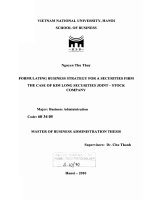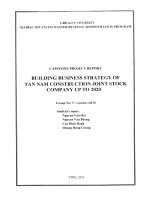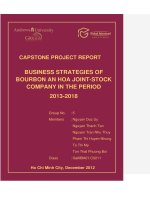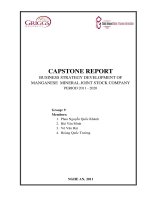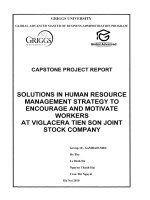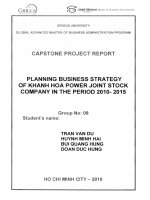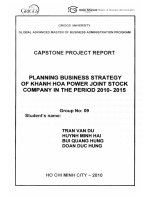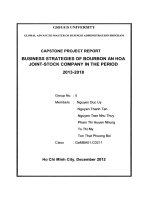2 ACCOUNTING FOR SALES AND DETERMINING BUSINESS RESULTS AT PDF REFRIGERATION ENGINEERING JOINT STOCK COMPANY
Bạn đang xem bản rút gọn của tài liệu. Xem và tải ngay bản đầy đủ của tài liệu tại đây (728.23 KB, 138 trang )
ACADEMY OF FINANCE
MINISTRY OF FINANCE
----🙣🙣🙣----
STUDENT: TRAN NHAT MAI
CLASS: CQ55/21CL.02
GRADUATION THESIS
TOPIC:
“ACCOUNTING FOR SALES AND DETERMINING BUSINESS
RESULTS AT PDF REFRIGERATION ENGINEERING JOINT
STOCK COMPANY”
Major
: Corporate Accounting
Code
: 21
Mentor : Ph.D Nguyen Minh Thanh
Ha Noi - 2021
Graduation Thesis
Academy Of Finance
COMMITMENT
I hereby declare that this is my own research project, the figures and results
stated in the graduation thesis are honestly derived from the actual situation of the
internship unit.
Graduate thesis author
Trần Nhật Mai
TABLE OF CONTENT
Tran Nhat Mai
1
CQ55/21CL.02
Graduation Thesis
Academy Of Finance
COMMITMENT........................................................................................................i
TABLE OF CONTENT.............................................................................................ii
LIST OF CHARTS....................................................................................................v
LIST OF DOCUMENTS..........................................................................................vi
SAMPLE TABE......................................................................................................vii
LIST OF ABBREVIATIONS.................................................................................viii
PREAMBLE.............................................................................................................. 1
CHAPTER 1: GENERAL THEORETICAL ISSUES FOR SALES AND
DETERMINING BUSINESS RESULTS IN COMMERCIAL ENTERPRISES.......4
1.1. Overview of sales and determining business results in commercial enterprises. 4
1.1.1. Features of the commercial business activity and the influence of the
characteristics of commercial business to sales accounting and determine business
results........................................................................................................................ 4
1.1.2. Concept and meaning of sales and determine business result..........................5
1.1.3 Method of sales and payment in businesses......................................................8
1.2. Financial accounting for sales and determining business results in the business.
................................................................................................................................. 10
1.2.1. Financial accounting for sales and service provision.....................................10
1.2.2. Financial accounting for sales deductions......................................................13
1.2.3. Financial accounting for cost of goods sold...................................................15
1.2.4. Financial accounting for financial income and financial expenses................19
1.2.5. Financial accounting for selling expenses and General & administration
expenses...................................................................................................................22
1.2.6. Financial accounting for other income and other expenses............................26
1.2.7. Financial accounting for corporate income tax expense................................29
1.2.8. Financial accounting for determining business results...................................31
1.3. Accounting books and accounting reports for use in financial accounting for
sales and determining business results.....................................................................33
1.3.1. Accounting books used in financial accounting for sales and determining
business results........................................................................................................33
Tran Nhat Mai
2
CQ55/21CL.02
Graduation Thesis
Academy Of Finance
1.3.2 Presented information on the financial accounting for sales and determining
business results on accounting reports.....................................................................34
1.4. Management accounting for sales and determining business result..................36
1.4.1. Concept of management accounting for sales and business results................36
1.4.2. Content of management accounting for sales and business results................36
1.4.3. The organization for management accounting for sales and business results.38
CONCLUSION CHAPTER 1:................................................................................40
CHAPTER 2:FINANCIAL ACCOUNTING FOR SALES AND DETERMINING
BUSINESS RESULTS IN PDF REFRIGERATION ENGINEERING JOINT
STOCK COMPANY................................................................................................41
2.1. Overview of PDF Refrigeration Engineering Joint Stock Company.................41
2.1.1. The process of formation and development of the company..........................41
2.1.2. Features of production and business organization of the company...............42
2.1.3. Organize management apparatus at the company..........................................43
2.1.4. Characteristics of the organization of the accounting work at the company...45
2.2. Accounting status of sales and determine business results at PDF Refrigeration
Engineering Joint Stock Company...........................................................................52
2.2.1. Characteristics of sales activities and determine business results at PDF
Refrigeration Engineering Joint Stock Company.....................................................52
2.2.2. Sales procedures and vouchers used in sales accounting at PDF Refrigeration
Engineering Joint Stock Company...........................................................................54
2.2.3. Financial accounting for sale and determining business results at PDF
Refrigeration Engineering Joint Stock Company.....................................................68
2.3. Comment on Financial accounting for sales and determining business results at
PDF Refrigeration Engineering Joint Stock Company...........................................100
2.3.1. General comments about the accounting at the Company............................100
2.3.2. Comment on sales accounting and determine business results at the Company.
............................................................................................................................... 103
2.3.3. Comment on Management accounting at the Company...............................105
CONCLUSION CHAPTER 2...............................................................................106
Tran Nhat Mai
3
CQ55/21CL.02
Graduation Thesis
Academy Of Finance
CHAPTER 3. SOME COMMENTS TO IMPROVE ACCOUNTING FOR SALES
AND DETERMINING BUSINESS RESULTS AT PDF REFRIGERATION
ENGINEERING JOINT STOCK COMPANY.......................................................107
3.1. Development orientation of PDF Refrigeration Engineering Joint Stock
Company...............................................................................................................107
3.2. Requirements and principles of perfecting accounting for sales and determining
business results at PDF Refrigeration Engineering Joint Stock Company.............108
3.2.1. Requirements of perfecting..........................................................................108
3.2.2. Principle of perfection.................................................................................109
3.3. Some ideas to improve accounting for sales and determine business results at
PDF Refrigeration Engineering Joint Stock Company...........................................110
3.3.1. Opinion 1: Apply discounts and rebates to promote sales activities.............110
3.3.2. Opinion 2: Make allocated cost of sales, cost of business management for
each commodity.....................................................................................................112
3.3.3. Opinion 3: Make Provision for bad receivable debts...................................114
3.3.4. Some other issues that need attention...........................................................118
3.4. Some ideas to improve Management Accounting for sales and determining
business results at PDF Refrigeration Engineering Joint Stock Company.............119
CONCLUSION CHAPTER 3...............................................................................120
GENERAL CONCLUDE......................................................................................121
Tran Nhat Mai
4
CQ55/21CL.02
Graduation Thesis
Academy Of Finance
LIST OF CHARTS
Chart 1: Sales accounting order...............................................................................12
Chart 2: Accounting order of sales deductions.........................................................15
Chart 3: Cost of goods sold accounting order according to regular declaration
method.....................................................................................................................18
Chart 4: Accounting order of financial income and financial expenses...................21
Chart 5: Financial accounting for Selling expenses and administrative expenses
procedures...............................................................................................................25
Chart 6: Accounting for other income sequences:...................................................28
Chart 7: Accounting for orther expenses order: Explain diagram:...........................29
Chart 8: Accounting for corporate income tax order...............................................30
Chart 9: Accounting order to determine business results.........................................32
Chart 10: Business process......................................................................................43
Chart 11. Organizational chart management apparatus of the company..................44
Chart 12. Organizational structure of the accounting apparatus...............................46
Tran Nhat Mai
5
CQ55/21CL.02
Graduation Thesis
Academy Of Finance
LIST OF DOCUMENTS
Document 01: Economic contract............................................................................55
Document 02: Form of wholesale VAT invoice.......................................................59
Document 03: Wholesale stock release note............................................................61
Document 04: Detailed retail list of goods..............................................................64
Document 05: Retail release note............................................................................65
Documents 06: Retail receipts.................................................................................66
Document 07: Retail VAT invoice...........................................................................67
Tran Nhat Mai
6
CQ55/21CL.02
Graduation Thesis
Academy Of Finance
SAMPLE TABLE
Sample table 01: Record the payment details for each customer object..................70
Sample table 02: Record the ledger of accounts receivable from customers...........71
Sample table 03: Ledger Account 511 - Sales of goods and services.......................72
Sample table 04: List of goods warehouse receipt...................................................76
Sample table 05: Report Import, export, inventory..................................................77
Sample table 06: The list of goods delivery bills.....................................................78
Sample table 07: Ledger Account 632 - Cost of goods sold....................................80
Sample table 08: Ledger Account 515 - Revenue from financial activities.............83
Sample table 09: Payment.......................................................................................87
Sample table 10: Ledger of account 641 - Selling expenses....................................89
Sample table 11: Ledger of accounts 642 - General and administrative expenses...91
Sample table 12: Account ledger 911 - Determine business results.........................96
Sample table 13: General journal.............................................................................98
Tran Nhat Mai
7
CQ55/21CL.02
Graduation Thesis
Academy Of Finance
LIST OF ABBREVIATIONS
Acc
Account
COGS
Cost of good sold
VAT
Value added tax
CIT
Corporate income tax
Tran Nhat Mai
8
CQ55/21CL.02
Graduation Thesis
Academy Of Finance
PREAMBLE
1. The urgency of the research topic
With the continuous advancement of human society, the market demand has
increased significantly. The market economy is creating both opportunities and
challenges for businesses in general and commercial enterprises in particular when
entering the market. To be able to survive and develop, each business must find a
suitable direction, grasp opportunities and create efficiency in the process of
production and business activities and commercial enterprises are not out of that
rule.
Commercial business activity which is a special economic activity, it serves as
the circulation of goods, bring products to consumers. The scope of commercial
business is very wide, it includes both domestic trade and international trade. And in
the current period, commercial activity is constantly evolving and expanding,
contributing significantly to the overall development of each national economy.
However, with the complicated changes of the world economy in general and
the economy of Vietnam in particular have been set for the commercial enterprise of
the challenges that must be overcome, and one of the challenges that is competition.
Competition is both a challenge but also a driving force for development. A
business that sells goods, increases revenue and makes a profitable business mean
that the enterprise has enough competitiveness in the market. That is why the
consumption of goods plays a very important role in the production and business
development strategy of each commercial enterprise, ensuring that the enterprise
exists and stands firmly in the market.
Recognizing that importance, accounting with the function of reflecting,
monitoring and providing useful information for commercial enterprise economic
decisions needs to be well organized and managed, especially in sales accounting to
contribute to the practical efficiency of the business of commercial enterprises.
Recognize the importance of this accounting, combined with equipped knowledge
in the process of studying at the school and actually gathered from accounting work
Tran Nhat Mai
1
CQ55/21CL.02
Graduation Thesis
Academy Of Finance
at the company, with the enthusiastic guidance of teachers in the faculty and the
enthusiastic help of the leaders of the company and the staff accountant, I have
researched and selected in-depth topics “Accounting for sales and determining
business results at PDF Refrigeration Engineering Joint Stock Company”.
2. Research purposes.
The purpose of researching the topic: to find out the actual situation of the
sales accounting organization and to determine the business results at the company.
Through research, we will see the advantages and disadvantages that need to be
promoted and the shortcomings that need remedial measures, propose timely
suggestions to improve the organization of accounting for sales and determine
business results of the company.
3. Research subject and scope.
Research subject: Organization of accounting sales and determine business
results in PDF Refrigeration Engineering Joint Stock Company
Scope:
+ Content : The topic focuses on researching the current situation of the
organization of sales accounting and determining business results at PDF
Refrigeration Engineering Joint Stock Company in the financial accounting
perspective. Theoretical research on the basis of accounting standards and
accounting regimes.
+ About space: Research at PDF Refrigeration Engineering Joint Stock
Company, address Number 12 - Lot 7; Urban Xuan Phuong Residence, Trinh Van
Bo Street, Xuan Phuong Ward, Nam Tu Liem District, Hanoi City, Vietnam
+ Time : Research theoretical issues and document survey current situation at
PDF Company in the period 2020
4. Research Methods
The topic uses the methods of Collecting primary and secondary
information sources from the school and PDF Refrigeration Engineering Joint Stock
Company, combined with the method of dialectical materialism:
Tran Nhat Mai
2
CQ55/21CL.02
Graduation Thesis
Academy Of Finance
- Dialectic method: Consider the dialectical relationships of the accounting
objects that consume products in a specific time or space.
- Methods of investigation, statistics, synthesis and analysis to provide
accounting models for product consumption in specific conditions.
5. Structure of the thesis
In addition to the introduction and conclusion, the topic also includes three
chapters:
Chapter 1: General theory of sales accounting and determination of business
results in commercial enterprises.
Chapter 2: Accounting of sales and determination of business results at PDF
Refrigeration Engineering Joint Stock Company.
Chapter 3: Some ideas to perfect the sales accounting and determine business
results at PDF Refrigeration Engineering Joint Stock Company.
Tran Nhat Mai
3
CQ55/21CL.02
Graduation Thesis
Academy Of Finance
CHAPTER 1: GENERAL THEORETICAL ISSUES FOR SALES AND
DETERMINING BUSINESS RESULTS IN COMMERCIAL
ENTERPRISES
1.1. Overview of sales and determining business results in commercial
enterprises
1.1.1. Features of the commercial business activity and the influence of the
characteristics of commercial business to sales accounting and determine
business results
1.1.1.1. Features of the commercial business activity
Commercial business activity means the implementation of one or more
commercial acts of traders giving rise to rights and obligations between traders or
between related traders, including the purchase and sale of goods, the supply of
commercial services and trade promotion activities for profit or socio-economic
policy implementation.
* Trading activities have the following characteristics:
- Activities: economic activity is basically the circulation of goods (goods
circulation is a combination of activities in the process of buying, selling,
exchanging and storing goods).
- Regarding goods: goods in commercial business include materials and
products of material and non-material form that enterprises buy for the purpose of
sale.
- Regarding the mode of goods circulation: commercial business has two main
forms of circulation: wholesale and retail.
- Regarding business organizations: can follow many different models such as
wholesale organizations, retail, general business companies, brokerage companies,
trade promotion companies, ...
- Regarding the movement of goods: the movement of goods is not the same,
depending on the source of goods and the industry (domestic goods, import-export
Tran Nhat Mai
4
CQ55/21CL.02
Graduation Thesis
Academy Of Finance
goods, ...). Therefore, the purchasing costs and the time for the goods to be moved
also vary between types.
1.1.1.2. Influence of commercial business characteristics on sales and
determining business results.
With the special characteristics and functions of the commercial industry as
above, it will affect the accounting in general and the sales accounting and
determine the business results in particular. Each business has its own
organizational models of trading different types of goods. Each type of goods has a
mode of movement as well as a different movement. This variety makes sales
accounting and performance determination more complicated. Therefore, the sales
accounting and business result determination must be more complete, overcoming
the shortcomings to become more complete and meet the needs of commercial
business activities in the best way.
1.1.2. Concept and meaning of sales and determine business result
1.1.2.1. Sales
Sales are the transfer of ownership of goods associated with most of the
interests and risks held to the customer, paid or accepted by the customer. This
process helps businesses convert capital in goods into monetary capital or capital in
payment. This is the last stage in the production and business process in each
business.
* The sales process can be divided into two phases:
- Phase 1: Based on economic contracts signed to deliver goods to customers.
- Phase 2: Customers pay or accept payments (through invoices, ...).
Enterprises have or will collect money, enough to offset the costs to produce or have
available and profitable products.
1.1.2.2. Determining the business results of the commercial enterprise.
Determining business results is the calculation and comparison between the
expenses spent and the revenue received in the period. If the revenue is greater than
the cost, the result is profit and vice versa, if the revenue is less than the cost, the
result is a loss. Determining business results is usually conducted at the end of a
Tran Nhat Mai
5
CQ55/21CL.02
Graduation Thesis
Academy Of Finance
business period, usually at the end of a month, quarter or year, depending on the
characteristics of the business and the management requirements of each business.
1.1.2.3. Management requirements for sales and determination of business
results.
Sales management and determining business results of the business is a real
requirement, it comes from the goals of the business. In particular, managing the
sales process and determining the sales results is one of the key and important
requirements of the business. If an enterprise manages well the selling stage, it can
ensure the target of fulfilling the consumption plan and accurately assessing its
production and business efficiency. So the problem posed for each business is:
- Manage the plan and implementation of the consumption plan for each
period, each customer, each economic activity.
- Quality control, design improvement and product branding are the goals
for the sustainable development of the business.
-
Manage to monitor each method of sale, each customer, the payment
situation of the customer, request payment in the right form, on time to avoid
loss, loss and congestion of capital. Enterprises must choose the form of product
consumption for each unit, each market, each customer in order to speed up the
consumption process, and at the same time, conduct market exploration,
research, and expansion of wholesale relations. sold at home and abroad.
- Strictly manage capital of finished products for consumption, closely
monitor selling expenses, business management costs, and check the legality,
reasonableness of the data, and distributed to consumers, ensuring that
determining the exact consumption is reasonable.
- For the accounting consumption must closely held, science ensures
determining the final outcome of the process of consumption, reflect and
supervise the implementation of obligations to the state fully and promptly time.
1.1.2.4. The role and duties of sales and determining business results.
Looking at the scope of businesses that consume finished products or sell
products is the decisive factor to the success or failure of the business. Consumption
Tran Nhat Mai
6
CQ55/21CL.02
Graduation Thesis
Academy Of Finance
shows the competitiveness and reputation of the business in the market. It is the
basis for evaluating the organization's ability to effectively manage production and
business activities. On the other hand, it also indirectly reflects the level of
organization of the supply, production as well as the storage and preservation of
finished products.
Across the entire economy, selling has a special role, it is both a condition for
social reproduction and a bridge between producers and consumers, reflecting the
meeting between supply and demand for goods, thereby driving production,
consumption and solvency.
For a business, increasing the sales process quickly increases the turnover of
capital, saves capital and directly increases the profitability of the business. From
there, it will improve the life and income of the employees in the enterprise and
fulfill their obligations to the state.
In business, accounting is an important tool to manage production and
consumption, through data of general accounting, sales accounting and in particular
to determine sales results in particular for businesses and businesses. the authority
to assess an enterprise's level of fulfillment in terms of production, cost,
consumption and profit.
To really be a tool for the management, accounting and sales results process,
must perform well, fully the following tasks:
+ Organize monitoring, accurately, fully and promptly monitoring the
existing situation and the fluctuation of each product.
+ Reflected and recorded in full, timely and accurate revenues, sales
deductions and the cost of each activity in the business.
Reflect and calculate the exact outcome of each activity and supervision on
the implementation of obligations to the state.
Providing accounting information serving the preparation of financial
statements and periodic analysis of economic activities related to the sales process,
determination and distribution of results. The sales accounting and sales results
determination must always be linked.
Tran Nhat Mai
7
CQ55/21CL.02
Graduation Thesis
Academy Of Finance
1.1.3 Method of sales and payment in businesses
1.1.3.1. The method of sales
The sale of goods in enterprises can be carried out by the following
methods:
* Wholesale method:
Wholesale is the sale of products of an enterprise to other businesses, stores,
agents ... In large quantities for units to continue to sell to other organizations or to
serve other purposes to economic needs. Wholesale of goods is usually done by two
forms:
- The form of wholesale through warehouse: goods are sold to customers from
the enterprise's stockpile and are done in two ways:
+ Form of direct selling: is a form of sale where the enterprise delivers goods
and delivers them directly to customers at a warehouse or a place of direct storage
of the enterprise. Goods are considered to be selling and forming sales when the
customer receives enough goods and signs the invoice to confirm the goods.
Vouchers used: sale invoice or VAT invoice, delivery slip made by the seller.
+ Form of shipment: in this form, periodically based on economic contract and
delivery plan, the company sends goods to customers and delivers them at the place
signed in the contract (station, port , the customer's warehouse, ...).
The goods sent are still owned by the seller. Only when the customer notices
to receive the goods and accepts to pay or pay for the goods immediately, then the
goods transfer of ownership is determined to be sales and the business is recognized
as sales. Shipping costs are borne by the enterprise or the buyer, depending on the
contract signed between the two parties. Use vouchers: sale invoices or VAT
invoices, invoices cum stock invoice issued by the enterprise.
- Direct wholesale is a form of sale in which the seller buys goods from a
supplier to sell to customers, the goods do not go through the seller's warehouse.
This form also includes many small forms:
+ Wholesale hand delivery (direct wholesale): Commercial enterprises buy
goods from the supplier for direct delivery to the buyer authorized by the buyer to
Tran Nhat Mai
8
CQ55/21CL.02
Graduation Thesis
Academy Of Finance
receive the goods directly at the place agreed by the two parties. pros. Goods are
considered to have been sold when the buyer has fully received the goods and
signed the receipt on the sale vouchers of the enterprise, and the payment depends
on the signed contract between the two parties.
+ Shipping wholesale directly in the form of shipping: Commercial enterprises
buy goods from the supplier and ship them to sell directly to buyers by means of
transport or outsource. Goods sent for sale still belong to the enterprise. When the
buyer confirms that they have received the goods or accepts the payment, then it
will be determined that they are consumed. Shipping costs depending on each
signed contract can be borne by the seller or the buyer.
* Retail method:
It is the last stage of transportation of goods from the manufacturing sector to
the consumer sector. At this stage, the goods end of circulation, the full value and
value of use can be realized. Retailers often sell with small volumes and stable
prices. Usually includes:
- Direct cash sales: sales are completed directly with customers.
Customers
pay money, sellers deliver goods to customers.
- Selling by agent mode: Selling businesses sign contracts with agents,
deliver goods to these establishments for sale and pay commissions for selling
them.
- Sales by installment or deferred payment: Sales businesses only collect a
part of the customer's money, the rest will be paid by installments and must bear a
certain amount of interest..
There are also other forms of selling such as selling online, on television ...
1.1.3.2. Methods of payment
* Instant payment by cash, bank deposit
Under this method, when the buyer receives the goods from the business, he
will immediately pay the business in cash or in bank deposit. This method is often
Tran Nhat Mai
9
CQ55/21CL.02
Graduation Thesis
Academy Of Finance
used in the case of buyers who are small customers who buy small quantities or
have immediate payment ability at the time of delivery.
* Selling and calculating interest
Under this method, the buyer pays money after receiving the goods for a
certain period of time agreed by both parties, at the end of which time the buyer
will have to pay all the purchased value plus an amount fee is the interest from this
delay.
* Sale installment
The installment payment method is essentially a lending method that, since
the corner and interest payment periods are the same, the amount of each payment
period is the same, the interest is calculated on the principal balance and the actual
number of days of the repayment term.
1.2. Financial accounting for sales and determining business results in the
business.
1.2.1. Financial accounting for sales and service provision.
1.2.1.1. The concept of revenue.
Revenue is the total value of economic benefits earned by an enterprise in
the accounting period, arising from normal business and production activities of an
enterprise, contributing to increase equity capital.
Turnover arising from a transaction or event is determined by an agreement
between the enterprise and the purchaser or asset user. It is determined by the fair
value of the proceeds or to be obtained after deduction of trade discounts, sales
rebates and the amount of sales returned.
Sales of goods are recognized when all five (5) of the following conditions
are satisfied at the same time:
+ The enterprise has transferred most of the risks and benefits associated
with the ownership of products or goods to the buyer;
+ The enterprise no longer holds the right to manage the goods as the goods
owner or the right to control the goods;
+ The revenue is determined with relative certainty;
Tran Nhat Mai
10
CQ55/21CL.02
Graduation Thesis
Academy Of Finance
+ The enterprise has received or will gain economic benefits from the sale;
Costs related to sales transactions can be determined
1.2.1.2. Vouchers used:
- VAT invoice or sales invoice; Delivery note cum internal transport; Payment
table for goods consigned by agent; Counter card; ...
- Payment vouchers (receipts, transfer checks, payment, collection orders,
credit notes, debit notes, statements ...).
1.3.1.3. Accounts used:
- Account 511: Revenue from goods sold and service provision. This account
reflects the enterprise's revenue from selling goods and providing services in 1
accounting period of production and business activities from transactions, sales
operations and service provision.
- This account has class 2 accounts as follows:
+ Account 5111- Revenue of goods
+ Account 5112- Revenue of semi-finished products
+ Account 5113 - Service revenue
+ Account 5114 - Revenue from price subsidies
+ Account 5117 - Revenue from real estate investment
+ Account 5118 - Other revenue.
- Account 3331: VAT payable. This account applies generally to VAT payers
according to the tax credit method and those to pay VAT according to the direct
method.
- Account 3387: Unearned revenue. This account is used to record
prepayments for asset lease, investment property lease; the difference between the
installment or deferred sale price and the spot price; interests received before
making loans or buying debt instruments; the selling price difference is greater than
the residual value of the fixed asset sold and then leased under the finance lease
method; the difference in selling price is greater than the fair value of the fixed
asset sold and then leased under the operating lease mode; Other deferred income
from contributing capital to joint ventures to establish a co-control base whose
Tran Nhat Mai
11
CQ55/21CL.02
Graduation Thesis
Academy Of Finance
capital contribution value is assessed to be greater than the actual value of
materials, products or goods or the residual value of fixed assets to be contributed
capital
- Other related accounts (Account 111,112,131,…).
1.2.1.4. Accounting sequence:
If the enterprise pays VAT by the deduction method, the revenue from
the sale of goods and services is recognized as the tax-exclusive selling price of
such goods or services.
If an enterprise pays VAT by the direct method, Sales of goods and
services are recognized as the total payment price of such goods or services.
Chart 1: Sales accounting order
Acc 521, 333
Acc 511
Acc 111, 112, 141, 136
(4)
(1)
Acc 3387
Acc 3331
(2b)
(5)
(2a)
Acc 334, 3532
Acc 911
(6)
(3)
Explanation of the diagrams:
Tran Nhat Mai
12
CQ55/21CL.02
Graduation Thesis
Academy Of Finance
(1) Turnover when selling directly to customers or internal units, when the
agent accepts payment, the immediate selling price of the installment sale or the fair
value of the materials or goods exchanged
(2a) Unrealized revenue (total payment price) upon receipt of rent in
advance from fixed assets or investment property leasing.
(2b) Periodically calculate and carry forward revenue from operating lease
of fixed assets or investment property leasing in the accounting period.
(3) Products or goods used for donation or salary payment (Internal
consumption is recognized as the normal selling price of the product)
(4) Transfer of sales deductions: sales rebates, sales returns, trade discounts,
excise tax, and export tax.
(5) At the end of the period of determining payable VAT amount
(6) At the end of the period, net revenue is transferred to determine business
results.
1.2.2. Financial accounting for sales deductions.
1.2.2.1. Content of sales deductions.
Sales deductions such as trade discounts, sales rebates, sales returned, VAT
payable under the direct method, and excise tax, and export tax. Revenue
deductions are the basis for calculating net sales and business results in the
accounting period. Revenue deductions must be reflected, tracked in detail and
separately on the appropriate accounts to provide information for the accountant to
prepare the financial statements.
- Trade discount: Is the difference in the selling price which is smaller than
the listed price discounted by the enterprise for the buyer because the buyer has
bought products or goods in large volume under the agreement on trade discount.
stated in the purchase and sale economic contracts or purchase and sale
commitments.
- Sales of returned goods: Is the number of products and goods that the
enterprise has determined to be consumed, has recorded revenue but is returned by
the customer due to violation of the conditions committed in the business contract.
Tran Nhat Mai
13
CQ55/21CL.02
Graduation Thesis
Academy Of Finance
economic or under warranty policy such as: Poor quality goods, wrong
specifications ...
- Sales discount: is the amount that the business (the seller) deducts to the
buyer in special cases because the goods sold are of poor quality, improper
specifications or on time as stated in the contract. .
- Some taxes such as: VAT according to the direct method, Special
consumption tax, Export tax.
1.3.2.2. Vouchers and accounts used:
- Vouchers used: warehouse receipts of goods sold are returned; Record of
discount agreement; Sales invoices returned; Payment note, bank debt notice; Tax
payment documents, ...
- User account:
Account 5211 - Trade discounts;
Account 5212 - Sales returned;
Account 5213 - Sales price reduction;
Account 3331 - VAT payable;
Account 3332 - Special consumption tax;
TK3333 - Import and export tax.
+ Other related accounts such as Account 111, Account 112, Account 131,
1.3.2.3. Accounting sequence.
Tran Nhat Mai
14
CQ55/21CL.02
Graduation Thesis
Academy Of Finance
Chart 2: Accounting order of sales deductions
Acc 3331,3332,3333
Acc 511
Taxes payable reduce sales
Direct VAT, excise tax, import and export duties
Acc 131,111,112
Acc 521
Trade discounts,
End of period, transferred
Sales discounts, sales returns
to calculate net revenue
Acc 3331
Reduce output VAT
1.2.3. Financial accounting for cost of goods sold.
1.2.3.1. The method of determining the cost of goods sold
For goods, the cost of goods sold includes the purchase value of the goods
for sale plus (+) the purchase cost of the goods for sale. For a finished product, the
cost of goods sold is the cost of the finished product sold in the period.
- The purchase value of goods for sale and the cost of the finished product for sale
are determined by one of the following three methods:
+ The actual nominal method: The purchase value of the goods, the cost of
the finished product is valued in a single unit or lot and remains the same from the
time of import to the time of use. When the shipment is released, the actual unit
price of that shipment will be calculated.
+ First-in-first-out method: Assuming which batch of goods or finished
products are imported first, they will ship first and take the actual price of that
import as the price of goods and finished products out of stock.
+ Weighted average unit price: The method of calculating the average unit
price after each importation. According to this method, only the weighted average
Tran Nhat Mai
15
CQ55/21CL.02
Graduation Thesis
Academy Of Finance
unit price of circulating goods at the end of the period is calculated and then the
cost value is calculated. of goods, finished products out of stock.
Each method has different advantages and disadvantages, depending on the
specific conditions of the business to choose the appropriate method.
- Purchase cost of goods for sale in the period is calculated by the following
formula:
Purchase costs
Purchase costs
of goods
of inventory at
Purchasing
the beginning
expenses of
of the period
goods for sale
=
during the
period
+
shipped during
Purchase
during the
value of
period
Purchase value
of goods
purchased
Purchase value
+
of ending
×
goods sold
(1.4)
for the
period
inventory
the period
1.2.3.2. Vouchers and accounts used.
- Use vouchers: Warehouse receipt, delivery note; Summary of export and
import; Price allocation table; Delivery note cum internal transport; Delivery note
of warehouse for sale to agent, ...
- User account:
+ Mainly using account 632 - Cost of goods sold.
If accounting for inventories according to the regular accounting method,
Account 632 reflects the cost of products, goods and services sold during the
period; Unallocated cost of raw materials and labor and fixed overheads are
included in cost of goods sold during the period; Loss or loss of inventory after
deduction of indemnity caused by personal liability; Costs of construction and
processing of fixed assets in excess of normal levels shall not be included in the
Tran Nhat Mai
16
CQ55/21CL.02

